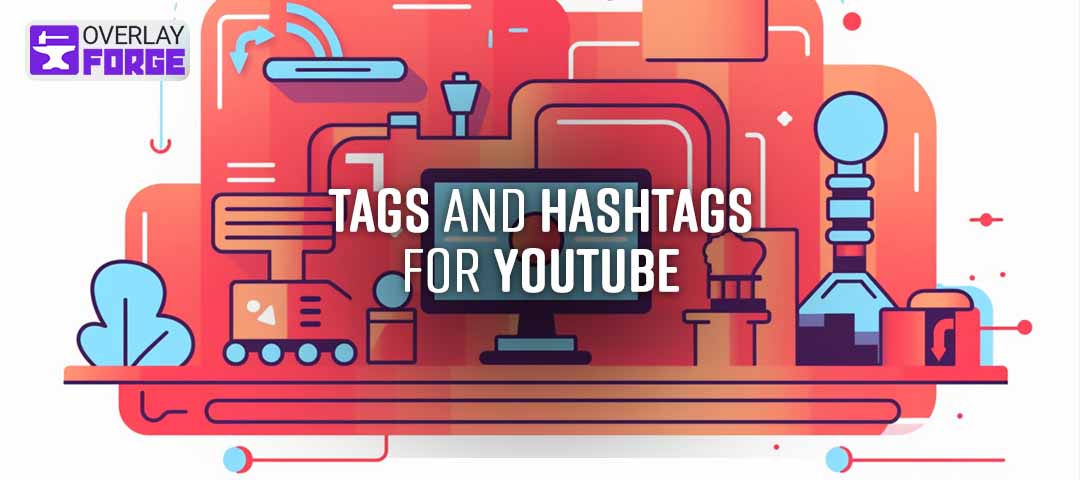Introduction
In today’s increasingly competitive digital landscape, it’s crucial to capitalize on every opportunity to ensure your YouTube content reaches the widest potential audience. One often overlooked yet highly effective method for increasing visibility, rankings, and views is the strategic use of YouTube tags and hashtags. This comprehensive guide will explore the importance of YouTube tags and hashtags and outline the key benefits of utilizing them effectively in your video marketing strategy.
As we delve into the world of YouTube optimization, we’ll discuss finding the best tags for your videos, implementing appropriate hashtags for better discoverability, and measuring the success of your tagging strategy. Additionally, we’ll cover the essential techniques to improve your overall YouTube SEO performance, including on-page optimization.
With these strategies in hand, you’ll be well-prepared to take your YouTube content to new heights, driving greater organic traffic and ensuring your videos stand out among the competition. So, without further ado, let’s get started on mastering the art of YouTube tags and hashtags.
What are YouTube Tags
YouTube tags are essentially keywords and phrases used to describe your video content. They help the YouTube algorithm understand the context and relevance of your video, ultimately assisting users in discovering your content when they search for related topics. Utilizing relevant and strategic tags can greatly improve your video’s chances of appearing in search results and suggested video recommendations.
YouTube’s algorithm analyzes the tags you include in your video, along with other metadata like title and description, to determine where your video will rank within both search results and video suggestions. By using accurate and relevant tags, you improve the likelihood that users searching for content similar to yours will find your video, thus boosting your overall reach and visibility.
When it comes to organic search rankings, YouTube tags play a vital role in helping your video appear higher in search results. By optimizing your tags to target high-volume keywords with appropriate competition levels, you increase the chances that your video will rank well within YouTube’s search results. This, in turn, drives more organic traffic to your videos and enhances your channel’s overall performance.
Finding the Best Tags for Your Videos

Identifying the most suitable tags for your videos is a crucial step in optimizing your YouTube SEO. The right tags can significantly enhance your video’s visibility, helping it reach the right audience at the right time. But how do you find the best tags for your videos?
Keyword research tools like Google Keyword Planner, Ahrefs, SEMrush, or free options like Ahrefs’ YouTube Keyword Tool can be incredibly helpful. These tools allow you to discover keywords related to your video’s topic or niche, providing insight into search volume, competition levels, and potential user interest.
40 Top Trending YouTube Tags For You
To help you get started, we’ve compiled a list of some of the best tags for various categories:
- Gaming: Gameplay walkthrough, Gaming tips and tricks, Latest game reviews, Gaming tutorials, Game updates
- Lifestyle: Healthy lifestyle tips, Home organization, Daily routines, Minimalist lifestyle, Self-care routines
- Tech: Tech reviews, Latest gadgets, Tech news, Innovation in tech, AI developments
- Travel: Travel vlogs, Travel guides, Budget travel tips, Adventure travel, Travel gear reviews
- Fitness: Fitness routines, Workout tips, Healthy diet plans, Fitness motivation, Gym workouts
- Food: Easy recipes, Healthy meals, Food reviews, Cooking tips, Baking tutorials
- Fashion: Fashion trends, Outfit ideas, Fashion hauls, Style tips, Fashion week updates
- Education: Study tips, Online courses, Educational resources, Learning techniques, Book summaries
When selecting tags for your video, it’s crucial to strike a balance between high-ranking keywords and long-tail keywords. High-ranking keywords have a higher search volume but are typically more competitive, while long-tail keywords have lower search volume but less competition. Using a mix of both types of keywords can improve your video’s chances of appearing in various search scenarios and reaching a wider audience.
Studying your competitors on YouTube can also provide valuable insights into effective tag usage within your niche. Analyze your competitors’ videos with a similar focus or subject matter and note the tags they use. This will help you identify common trends and potentially untapped opportunities for your own content.
However, while it may be tempting to use popular or trending tags to boost your video’s chances of being discovered, it’s crucial to prioritize relevance and accuracy in your tag selection. Using irrelevant or misleading tags can negatively affect user experience, potentially leading to lower engagement and watch time metrics. To ensure the success of your videos and maintain credibility with your audience, always opt for tags that accurately represent your content.
YouTube Hashtags
While both YouTube tags and hashtags serve the purpose of improving discoverability, there are key differences between the two. YouTube tags consist of keywords and phrases added within the YouTube Studio that assist the algorithm in understanding and categorizing your video. In contrast, hashtags are added to your video’s description and appear as clickable links above the video title, allowing users to quickly discover similar content within the platform using these hashtag searches.
Best Practices for Using Hashtags
- Use relevant hashtags: Similar to tags, always choose relevant hashtags that accurately represent your video content, which will help attract the right audience and maintain credibility.
- Focus on a limited number of hashtags: While YouTube allows up to 15 hashtags, it’s advised to use 3-5 strategically chosen hashtags to prevent your video from being flagged as spam or removed due to excessive hashtag usage.
- Include a mix of specific and broad hashtags: This approach ensures that you tap into both niche and popular categories, increasing the chances of your content being discovered by a wider audience.
Top Niche Hashtags
Depending on your content’s subject matter and target audience, hashtag usage may vary. Here are some examples for different content niches:
- Gaming: #GamingCommunity, #Gameplay, #LetsPlay
- Tech reviews: #TechReview, #GadgetReview, #Unboxing
- Fashion or beauty: #OOTD (Outfit of the Day), #MakeupTutorial, #FashionHaul
- Travel vlogs: #TravelVlog, #Wanderlust, #TravelInspiration
- Tutorials and DIY: #HowTo, #DIYProject, #LifeHacks
How to find the best Hashtags for your video
- Explore YouTube search: Enter a relevant keyword or search term in the YouTube search bar, and YouTube will suggest various popular hashtags related to the term, giving you an idea of trending and effective hashtags.
- Analyze competitors and similar channels: Look at the hashtags used by popular channels and creators within your niche. Viewing their video descriptions and noting the hashtags they use can provide you with ideas for hashtags relevant to your content and target audience.
- Social media hashtag research: Investigate popular hashtags used on other social media platforms such as Instagram, Twitter, and Facebook, as these can often be applicable to YouTube content as well.
- Use hashtag generator tools: Tools like KeywordTool.io can provide suggestions for relevant and popular hashtags based on keywords you enter.
Remember to conduct thorough research and select the most relevant and effective hashtags that cater to your specific content and audience’s interests. By utilizing these methods, you can improve your video’s discoverability and overall reach.
How to Add Tags and Hashtags to Your YouTube Videos
You’ve got your tags and hashtags ready, and you’re eager to see how they can boost your video’s visibility. But how do you add them to your YouTube videos? If you’re unsure about the process or just need a quick refresher, you’re in the right place. In this section, we’ll guide you through the simple steps of adding and editing tags within the YouTube Studio, as well as incorporating hashtags into your video descriptions. Let’s get started!
Adding and editing tags within the YouTube Studio
- Sign in to YouTube and click on your profile icon in the top right corner, then select ‘YouTube Studio’.
- In the left panel, click on ‘Content’ to view your video list.
- Locate the video you want to add or edit tags for and click on the ‘pencil’ (Details) icon to open the video’s details page.
- Scroll down to the ‘Tags’ section and type in your chosen tags, separating each with a comma.
- Once you have added all necessary tags, click the ‘Save’ button at the top right to save your changes.
Adding hashtags to your video descriptions
- In the YouTube Studio, open the video’s details page as described earlier.
- Locate the ‘Description’ field and type in your chosen hashtags, preceded by the ‘#’ symbol (e.g., #examplehashtag). Remember to maintain relevancy and follow YouTube’s guidelines regarding the number of hashtags.
- After adding the hashtags, click the ‘Save’ button at the top right to save your changes. The hashtags will now appear as clickable links above the video’s title, which will direct users to search results pages containing other videos with the same hashtags.
Guidelines and Best Practices

Navigating the world of YouTube tags and hashtags can be daunting. Still, with a few guidelines and best practices, you can effectively use them to enhance your video’s visibility and reach. Here are some key points to keep in mind:
- Relevance is Key: Always ensure your tags and hashtags accurately represent your video content. Irrelevant or misleading tags can harm your video’s performance and lead to lower engagement.
- Avoid Keyword Stuffing: While adding as many tags as possible might be tempting, it can hurt your video’s performance. YouTube recommends using a few relevant tags rather than a long list of keywords. This applies to hashtags too. Stick to 3-5 strategically chosen hashtags.
- Use a Mix of Broad and Specific Tags: Broad tags can help your video appear in a wide range of searches, while specific tags can help you target a more niche audience. Using a mix of both can help maximize your video’s reach.
- Keep Up with Trends: Popular tags and hashtags can change quickly, so it’s important to stay up-to-date with the latest trends. However, always ensure trending tags are relevant to your video before using them.
- Use Keyword Tools: Tools like TubeBuddy and VidIQ can help you find popular and relevant tags for your videos. These tools can provide valuable insights into what your target audience is searching for.
- Don’t Over-rely on Tags and Hashtags: While tags and hashtags are essential for YouTube SEO, they’re not the only factors that influence your video’s visibility. Your video’s title, description, and content are equally, if not more, important. So, make sure to optimize these as well.
- Monitor Your Performance: Monitor your video analytics to see how your tags and hashtags perform. If a video isn’t performing as well as you’d like, don’t be afraid to experiment with different tags.
Remember, using tags and hashtags effectively is more of an art than a science. It takes time, experimentation, and a deep understanding of your audience. But with these guidelines and best practices, you’re well on your way to mastering YouTube tags and hashtags.
Optimize Your Youtube Content Beyond Hashtags

To fully leverage the power of tags and hashtags, it’s important to combine them with on-page optimization techniques. These practices create a comprehensive approach to improving your video’s discoverability and performance.
- Optimize video titles: Craft compelling and keyword-rich titles that accurately convey the content of your video, while also enticing users to click and watch.
- Write engaging descriptions: Include relevant keywords, hashtags, and a clear summary or overview of your video content in the description to make it more discoverable and accessible to viewers.
- Add captions and subtitles: These can not only improve user experience for those with hearing disabilities or language differences, but they can also enhance the discoverability of your video, as YouTube’s algorithm can index the text as part of your video’s content. AI tools like Speak AI, Trint, and Otter.ai can automate this process and help you.
- Utilize end screens and annotations: Encourage viewers to interact with your content, such as suggesting related videos, promoting your channel, or inviting them to subscribe or comment.
Final Thoughts and Key Takeaways
In conclusion, mastering the art of YouTube tags and hashtags is an essential aspect of today’s video marketing landscape. They play a pivotal role in boosting your video’s reach, organic traffic, and overall performance by elevating your content’s discoverability on the platform. By strategically selecting relevant, well-researched tags, and implementing effective hashtags, you lay the groundwork for an impactful YouTube strategy.
To get the most out of your tagging efforts, it’s crucial to take a holistic approach. By maintaining consistency across all metadata elements, including titles, descriptions, and meta tags, you ensure that the YouTube algorithm can effectively categorize your content. Combining this strategy with other on-page optimization techniques will help you get higher engagement and improved search rankings.
Moreover, as digital trends and best practices continually evolve, staying up-to-date with the latest YouTube algorithm updates and industry standards remains vital. Adapting your tagging strategy based on data-driven insights and changes within the platform will keep your content relevant and competitive within the ever-growing sea of YouTube videos.
In summary, by harnessing the power of tags and hashtags, developing consistent metadata, and embracing a comprehensive approach to YouTube SEO, you can maximize your YouTube content’s potential and successfully engage a wider audience in an ever-evolving digital landscape. Embracing these strategies will empower you to construct a solid foundation for sustainable growth and lasting success on YouTube.


